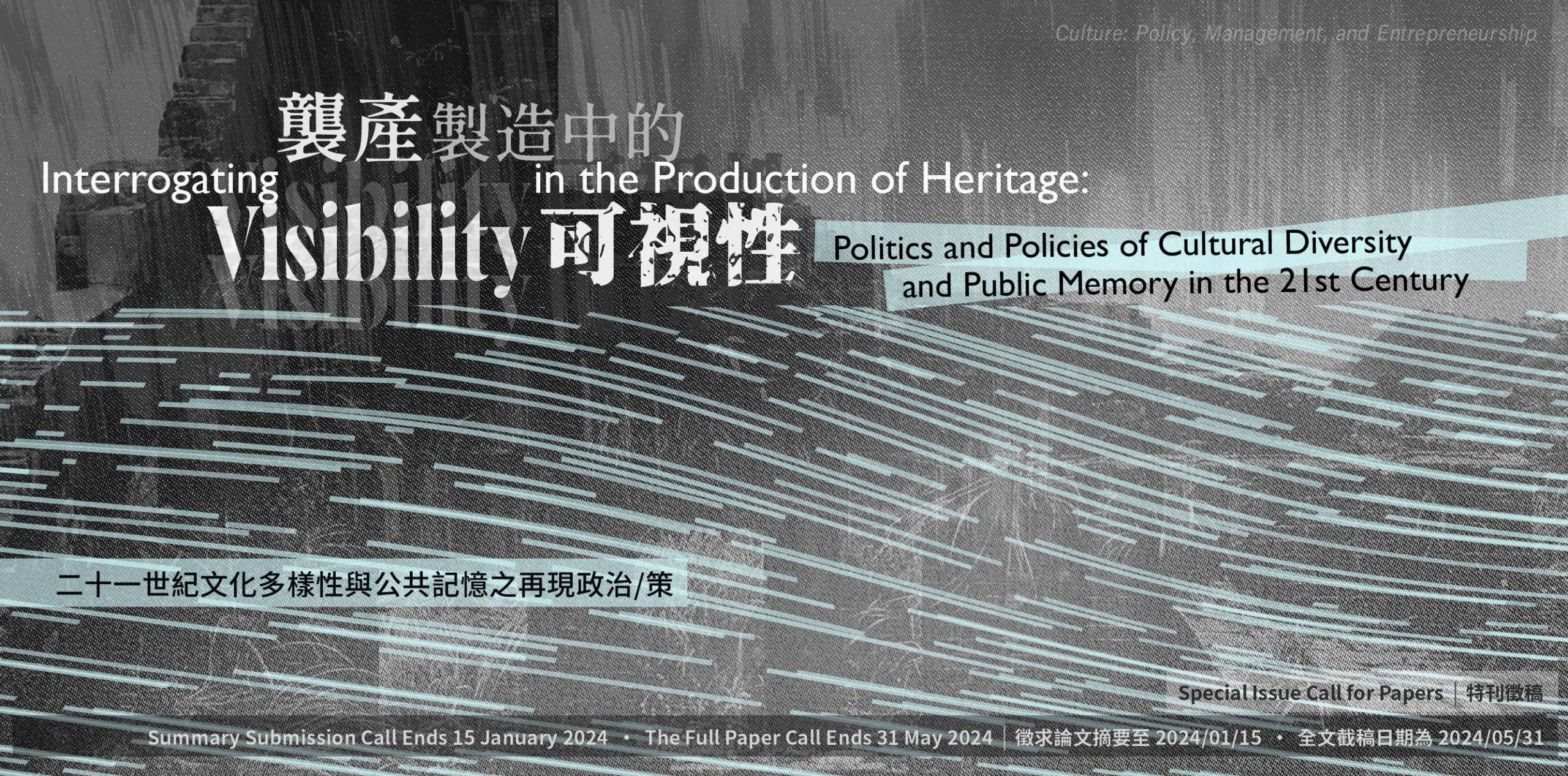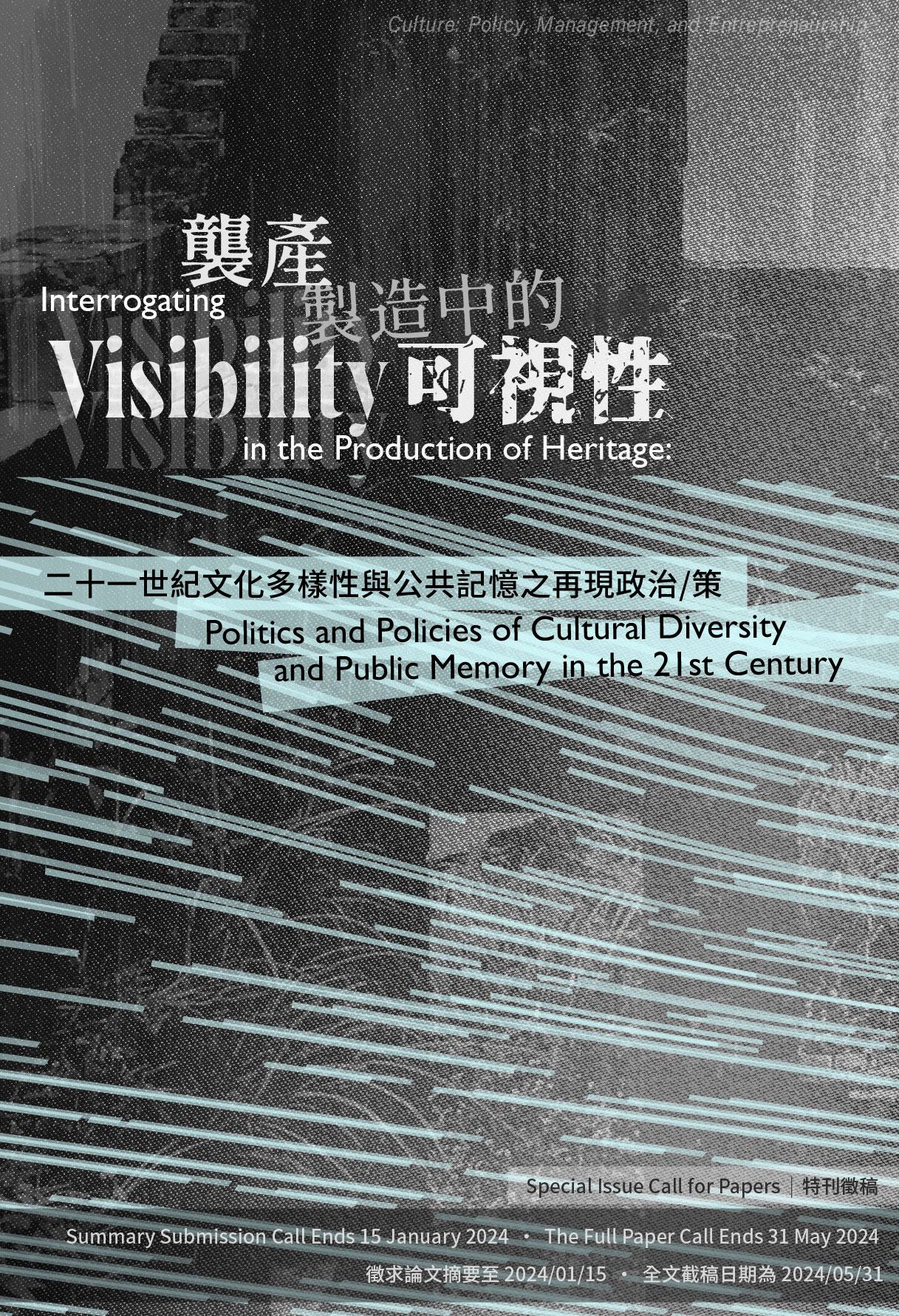

Call for Summary Ends: January 15, 2024.
Call for Full Paper Submission Ends: May 31, 2024.
The special issue “Interrogating Visibility in the Production of Heritage” continues its call for full papers until 31 May 2024. Article submissions should be emailed to cpme@tacps.tw.
Guest editors for the Special Issue:
- Shu-Mei Huang Associate Professor at the Graduate Institute of Building and Planning, National Taiwan University.
- Shu-li Wang Associate Research Fellow, Institute of Ethnology, Academia Sinica.
Hyun Kyung Lee Assistant Professor, Critical Global Studies Institute (CGSI), Sogang University, Seoul.
…visibility is not only an effect of power but also its condition of possibility.
Gordon (2002, 132)
Nearly three decades after Martin Jay (1995) offered a critical survey of the operation/domination of sight in human history, we still live in a world in which “visibility” is disproportionately prioritized over other sensual or spiritual qualities. Particularly in areas involving the past, and thereby the rearticulation of cultural identity and historic imaginaries, visibility contributed to a way of knowing that prioritized materiality and positive knowledge. In other words, “visibility” has been seen as a key throughout the production of heritage, which is exactly what this special issue would like to call into question. We believe that this investigation is particular important in the 21st century when “cultural diversity” prevails in policy documents (such as in Education for sustainable development – ESD – UNESCO’s education sector or UN’s SDGs) and international competitions (such as in how the Academy of Motion Picture Arts and Sciences updated its equity and inclusion initiative to encourage a more diversified representation).
Heritage plays a role in advancing visibility and cultural diversity. ICOMOS published a policy guidance for heritage and development actors in 2021 -allegedly the first of its kind – to offer heritage-based approaches sustainable development goals and to demonstrate how heritage can be instrumental much more than conventionally assumed (Labadi et al. 2021). Heritage, moreover, is seen as a key to fostering intercultural understanding by diversifying public memory and vision and yet diversity has its limit in meeting with spatial conflicts. In Seoul, many visitors checked out the iconic Dongaemun Design Plaza for its impressive architecture designed by Zaha Hadid. As soon as they stepped out from the metro station, they were then led to wonder over the archaeological remains from the Joseon dynasty, which largely enabled them to understand the city in a much more historical frame (Lee 2018). In Keelung, over the archaeological site of the Spanish Todos los Santos Church, the city officers of Keelung and the archaeologists from Taiwan and Spain competed with one another to lay out plans of varying degree of visibility of the ruins on-site or off-site for the different agendas in relations to different drafting of possibilities. While “the past ” is recalled and augmented by AR technology, villagers who reside nearby the site live in the shadows, just like the rather invisible memories of sport games at the already demolished Dongdaemun Stadium. Researchers of critical thinking would then easily raise questions in relation to the possibilities behind the particular curation of visibility: such as “possibilities for whom” or “what power geometry is behind the curation of visibility.” Upon limited space, ‘visibility’ matters as it is located into the memory competition, and selecting visibility implies invisible parts – heritage/memory ethics, politics/policies, historical perspectives and so on.
In the light of “regime of visibility” (De Backer 2019) and following how Brighenti (2007) reminds us “recognition and control are understood and explained as two opposing outcomes of visibility” (323), we are inviting papers to reflect on visibility-as-control (largely in Foucault’s sense), visibility-as-recognition (in a sense of resistance), and moreover, visibility-as-appropriation (or visibility-as-(re)appropriation, to be more explicit in postcolonial sense). Certainly, the issue of (in)visibility is not limited to the archaeological findings as a socially embedded creative practice. We welcome papers that examines visibility upon the preservation, representation, and even the consumption of heritage in a broad sense, ranging from how historical preservation is mobilized to lay claims for restorative social justice to how disappeared historical scenes are reconstructed in a film to enable alternative paths of dialogues and actions that were not possible before.
We also would like to see works that discuss how the state, most likely a new patron state (Lee 2019) is involved in the production of knowledge and at the same time the ethics of (in)visibility (as opposed to invisibility) becomes an inevitable issue, especially in the context of postcolonialism and settler colonialism. It is important to keep in mind about the often-neglected tension between visibility and invisibility, such as how Tracy Ireland (2015, 105) potently pointed out historical preservation might reinforce “the invisibility of the pasts of indigenous and other marginalised groups and perpetuates their absence from the representational and symbolic spaces of the city” in Australia.
We look forward to receiving submissions that address one of the following themes in relation to politics and policies of cultural diversity and public memory in the 21st century.
- Visibility and Policies of cultural diversity
- Heritage, visibility, sustainable development
- Regimes of visibility
- (In)visibility in heritage policies
- (in)visibility and public memory formation
- Cultural politics of (in)visibility
- Cultural consumption of visibility
- Visibility, reality or hyper-reality and technology of visibility
References:
Brighenti Andrea Mubi. 2007. “Visibility: A Category for the Social Sciences.” Current Sociology, 55: 323-342.
De Backer, Mattias. 2019. “Regimes of Visibility: Hanging out in Brussels’ Public Spaces.” Space and Culture, 22(3): 308-320.
Gordon, Neve. 2002. “On Visibility and Power: An Arendtian Corrective of Foucault.” Human Studies, 25, 125–145.
Hochberg, Gil Z. 2015. Visual Occupations: Violence and Visibility in a Conflict Zone. Duke University Press.
Ireland, Tracy. 2015. “The Ethics of Visibility: Archaeology, Conservation and Memories of Settler Colonialism.” In The Ethics of Cultural Heritage edited by Tracy Ireland, and John Schofield, 105-125. New York: Springer Science and Business Media.
Jay, Martin. 1993. Downcast Eyes: The Denigration of Vision in Twentieth-century French Thought. California, US: University of California Press.
Labadi, Sophia, Francesca Giliberto, Ilaria Rosetti, Linda Shetabi, and Ege Yildirim, 2021. Heritage and the Sustainable Development Goals: Policy Guidance for Heritage and Development Actors. Other. ICOMOS 134p. ISBN 978-2-918086-87-1.
Lee, Hyun Kyung. 2018. “Recreating Dongdaemun Stadium in South Korea: Beyond Japanese Colonial Memories and towards a Global City.” Seoul Journal of Korean Studies, 31(1): 99-128.
Lee, Hyun Kyung. 2019. “The New Patron State in South Korea: Cultural Policy, Democracy and the Market Economy.” International Journal of Cultural Policy, 25(1): 48-62.
Summary submissions (no longer than 300 words in English, and 500 words in Chinese) with the Authors Profile for CPME should be emailed, as Microsoft Word attachments, to CPME at cpme@tacps.tw by 15 January 2024. After selection, which will be released by 15 Feb 2024, we are expecting to receive the full paper by 31 May 2024 (No longer than 10,000 words in English, and 12,000-20,000 words in Chinese in CMS Style). We are looking at having the Special Issue to be published in May 2025.)
